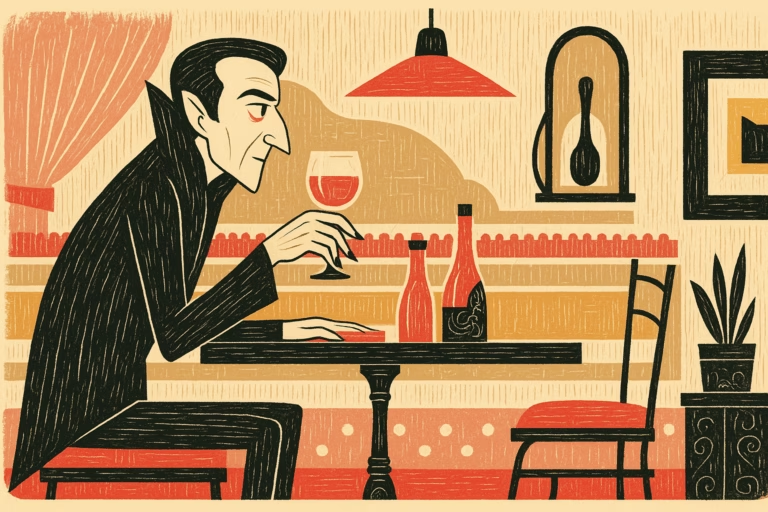Popes, Power, and Pours: Châteauneuf-du-Pape
If Vatican City is where wine and ritual meet in holy matrimony, Châteauneuf-du-Pape is where that union first got lit.

After having honored Pope Francis’s passing with a post on Vatican wine—celebrating wine’s cherished role in the Vatican and the papacy—it feels only right to follow up in a similar spirit. With Pope Leo XIV’s recent election (an American pope!) and a very compelling watch of Conclave—which I highly recommend—my thoughts naturally turned again to the intersection of papal power and the grape. And no place embodies that union more than Châteauneuf-du-Pape.
If Vatican City is where wine and ritual meet in holy matrimony, Châteauneuf-du-Pape is where that union first got lit.
Literally “the Pope’s new castle,” this sun-drenched Southern Rhône village has been pouring up piety since the 1300s. The story starts when Pope Clement V moved the papal seat from Rome to Avignon—setting the stage for nearly 70 years of French papal rule and one very thirsty legacy. His successor, Pope John XXII, picked a nearby hilltop village for his summer digs, expanded the vineyards, and gave the place its name. Wine was no longer just a sacrament—it was status. And for the papacy, nothing said divine right like a full-bodied red from your personal château.
From Papal Summer Home to Southern Rhône Royalty: Châteauneuf-du-Pape

Today, Châteauneuf-du-Pape isn’t just one of the Rhône Valley’s most prestigious appellations—it’s a masterclass in how terroir and tradition age beautifully together.
The landscape looks like something out of a wine-soaked fever dream: gnarly old vines twisted between galets roulés (those giant pudding stones that trap heat during the day and keep things cozy at night), a Mediterranean breeze, and just enough altitude to keep things balanced. It’s a place where sun, stone, and spirit collide.
The wines? Big, bold, and built to last—but also surprisingly nuanced, depending on who’s behind the bottle. Most are blends, but the magic is in the mix.
What’s Allowed in Wine from Châteauneuf-du-Pape
Châteauneuf-du-Pape allows a famously generous palette of grapes—but the list isn’t a free-for-all. Red wines and white wines each have their own sanctioned (and sacred) lineup.
🍷 Grapes permitted in red Châteauneuf-du-Pape:
Most reds revolve around these four stars:
Grenache Noir
The soul of the blend. Lush with cherry, strawberry, and spiced plum, Grenache is what makes Châteauneuf feel warm, generous, and just a little wild. Its high alcohol potential gives the wine its voluptuous structure, while hints of wild herbs (garrigue) root it in the southern French landscape.
Syrah
The muscle and mystery. It brings color, dark fruit, and a signature peppery bite. Syrah adds backbone and just a little brooding edge—like the introvert in the corner who’s definitely the most interesting person at the party.
Mourvèdre
The anchor. Deep, earthy, and brambly, Mourvèdre brings tannin and structure, plus that moody, animal funk that makes age-worthy wines sing. It’s the reason your bottle might still be glowing after a decade or two.
Cinsault
The charmer. Delicate and floral, Cinsault adds lift, softness, and aromatic elegance. Think rose petals and red currants. It’s the flirtatious whisper in a wine that otherwise means serious business.
Other red grapes
In total, thirteen varietals are allowed to appear in red Châteauneuf-du-Pape blends, including: Counoise, Vaccarèse, Terret Noir, Muscardin, Picpoul Noir, Clairette (Blanc and Rose), Bourboulenc, Roussanne, and Picardan.
💡 Fun fact: In Châteauneuf-du-Pape, winemakers are allowed to blend white grapes into red wines. While it’s not super common today, this traditional practice can add floral notes, lift, and elegance to the final blend. Roussanne or Clairette, for instance, might make a cameo in a red wine if the winemaker wants to soften the tannins or boost aroma.
🍾 Grapes permitted in white Châteauneuf-du-Pape:
White Châteauneuf-du-Pape makes up a small sliver of the region’s production, but don’t overlook it. These wines can be golden and plush, with notes of pear, fennel, and white flowers. Grenache Blanc and Roussanne are usually the stars—delivering waxy texture, warm stone fruit, and a touch of honey—but Bourboulenc and Clairette keep things fresh and structured. Picpoul (Blanc and Gris) or Picardan may also show up to balance things out.
More Than a Label—The Legacy of Châteauneuf-du-Pape
Look closely at a bottle and you’ll likely spot the embossed papal seal: the tiara and crossed keys of St. Peter. That’s not branding—it’s benediction. A centuries-old nod to the popes who put this village on the wine map.
And that blend of tradition and reverence is exactly what makes Châteauneuf feel so special. It’s not wine chasing trends—it’s wine that is the trend. For collectors, it’s a cellar essential. For romantics, it’s history in a glass. And for anyone reflecting on what faith, power, or even pleasure looks like in 2025, it’s a timely reminder that wine—like the papacy—is a ritual of continuity.
So whether you’re toasting Pope Leo’s debut, settling in with Conclave, or just opening something bold on a quiet Wednesday, consider Châteauneuf-du-Pape and toast to old vines, new leaders, and wines with a past as layered as their finish.



